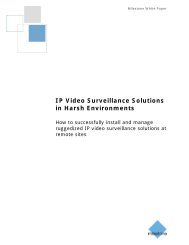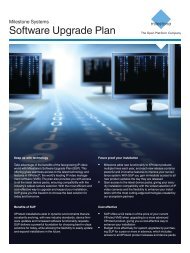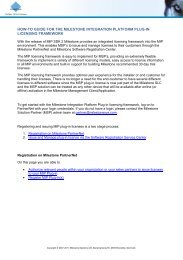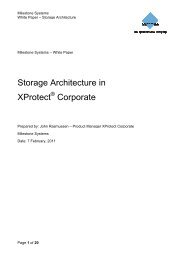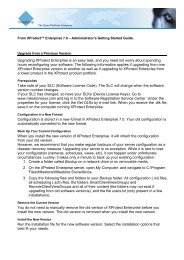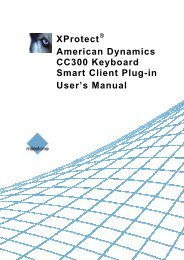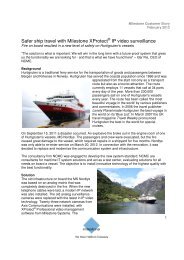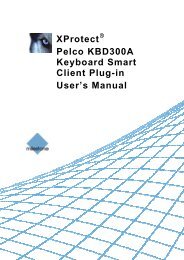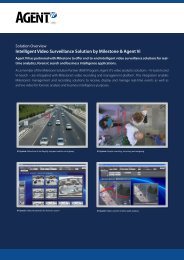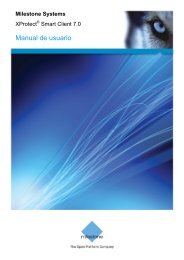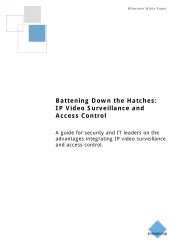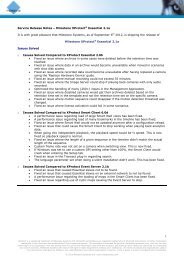XProtect Express 1.1; Administrator's Manual - Milestone
XProtect Express 1.1; Administrator's Manual - Milestone
XProtect Express 1.1; Administrator's Manual - Milestone
Create successful ePaper yourself
Turn your PDF publications into a flip-book with our unique Google optimized e-Paper software.
<strong>Milestone</strong> <strong>XProtect</strong> ® <strong>Express</strong> <strong>1.1</strong><strong>Administrator's</strong> <strong>Manual</strong>NameShortcutRecording PathArchiving PathRetention TimeCameraSelect AllClear AllSet selected template value onselected camerasDescriptionUsers of the Smart Client can take advantage of keyboard shortcuts, someof which let the users toggle between viewing different cameras. Suchshortcuts include numbers which are used to identify each camera.Shortcut numbers must be unique for each camera. A camera shortcutnumber must not contain any letters or special characters, and must not belonger than eight digits.Examples of correct camera shortcut numbers: 3, 12345678.Examples of incorrect camera shortcut numbers: Cam#3, 123456789.More information about using the keyboard shortcuts is available in theseparate documentation for the Smart Client.Path to the folder in which the camera's database should be stored. Defaultis C:\MediaDatabase. To browse for another folder, click the browse iconnext to the required cell. You can only specify a path to a folder on a localdrive. You cannot specify a path to a network drive. If you use a networkdrive, it is not be possible to save recordings if the network drive becomesunavailable.If you change the recording path, and you have existing recordings at theold location, you are asked whether you want to move the recordings to thenew location (recommended), leave them at the old location, or deletethem.Tip: If you have several cameras, and several local drives are available,you can improve performance by distributing individual cameras' databasesacross several drives.Only editable if not using dynamic paths for archiving (see "Aboutarchiving" on page 118). Path to the folder in which the camera's archivedrecordings should be stored. Default is C:\MediaDatabase.To browse for another folder, click the browse icon next to the required cell.You can specify a path to a local or network drive. If you change thearchiving path, and there are existing archived recordings at the oldlocation, you will be asked whether you want to move the archivedrecordings to the new location (recommended), leave them at the oldlocation, or delete them. Note that if you move archived recordings,<strong>XProtect</strong> <strong>Express</strong> will also archive what is currently in the cameradatabase. In case you wonder why the camera database is empty just afteryou have moved archived recordings, this is the reason.Total amount of time for which you want to keep recordings from thecamera (that is recordings in the camera's database as well as anyarchived recordings). Default is 30 days.Note that the retention time covers the total amount of time you want tokeep recordings for. In earlier <strong>XProtect</strong> <strong>Express</strong> versions, time limits werespecified separately for the database and archives.Click the Open button to configure detailed and/or camera-specific settings(such as event notification, PTZ preset positions, and fisheye view areas)for the selected camera.Click button to select all cameras in the Apply Template column.Click button to clear all selections in the Apply Template column.Apply only a selected value from the template to selected cameras.Tip: To select more than one value press CTRL while selecting.www.milestonesys.com 81 Advanced configuration



